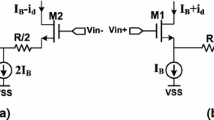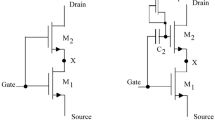Abstract
In this article, a novel design of a local-feedback MOS transconductor using a technique of canceling mobility degradation and a linearization technique of differential output current characteristics is proposed. In the proposed techniques, adaptively biasing current sources are employed to improve linearity deterioration due to mobility degradation effect and to terminate differential output nodes for elimination of second-order nonlinear terms. The proposed transconductor has good linearity. Simulation results show that the proposed techniques are effective for improvement of linear characteristics.















Similar content being viewed by others
References
Pennock, J. L. (1985). CMOS triode transconductor for continuous-time active integrated filters. Electronics Letters, 21(18), 817–818.
Wang, Z. (1990). Novel linearisation technique for implementing large-signal MOS tunable transconductor. Electronics Letters, 26(2), 138–139.
Szczepanski, S., Wyszynski, A., & Schaumann, R. (1993). Highly linear voltage-controlled CMOS transconductors. IEEE Transactions on Circuits and Systems Part I: Fundamental Theory and Applications, 40(4), 258–262.
Bult, K., & Wallinga, W. (1986). A CMOS four-quadrant analog multiplier. IEEE Journal of Solid-State Circuits, SC-21(3), 430–435.
Seevinck, E., & Wassenaar, R. F. (1987). A versatile CMOS linear transconductor/square-law function circuit. IEEE Journal of Solid-State Circuits, SC-22(3), 366–377.
Nedungadi, A., & Viswanathan, T. R. (1984). Design of linear CMOS transconductance elements. IEEE Transactions on Circuits and Systems, CAS-31(10), 891–894.
Sodini, C. G., Ko, P. K., & Moll, J. L. (1984). The effect of high field on MOS device and circuit performance. IEEE Transactions on Electron Devices, ED-31(10), 1386–1393.
Zarabadi, S. R., & Ismail, M. (1994). Linear voltage to current converter including feedback network. US Patent, 5317279.
Ibaragi, E., Hyogo, A., & Seikine, K. (1998). A novel CMOS OTA free from mobility degradation effect. In Proc. 1988 IEEE Asia Pacific Conference of Circuit and Systems, pp. 241–244.
Matsumoto, F., Onizawa, K., Nakamura, S., Takeuchi, H., & Noguchi, Y. (2009). A new linear transconductor for gyrator-type active filters. In ISPACS 2009, TA2-C-1, Dec 2009, pp. 272–275.
Tanimoto, H., Koyama, M., & Yoshida, Y. (1991). Realization of a 1-V active filter using a linearization technique employing plurality of emitter-coupled pairs. IEEE Journal of Solid-State Circuits, 26, 937–945.
Author information
Authors and Affiliations
Corresponding author
Rights and permissions
About this article
Cite this article
Tongpoon, P., Matsumoto, F., Takeuchi, H. et al. A novel design of local-feedback MOS transconductor using techniques for cancellation of mobility degradation and linearization of differential output current characteristic. Analog Integr Circ Sig Process 72, 565–574 (2012). https://doi.org/10.1007/s10470-011-9783-6
Received:
Revised:
Accepted:
Published:
Issue Date:
DOI: https://doi.org/10.1007/s10470-011-9783-6




